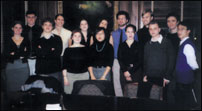 |
 |
 |
 |
|
AROUND THE QUADS
How can the three main subway stations that serve Columbia be improved? That was the issue tackled last fall by 16 students from the College, SEAS and Barnard, who participated in a seminar, "The Shape of New York: Transportation and Urban Development," taught by Professor Hilary Ballon, chair of the Department of Art History and Archaeology. The class culminated in The Subway Project, a collaborative effort among the students, mostly majors in architecture, art history and urban studies, who formed three task forces to examine the subway stations on Broadway at 116th, 125th and 168th Streets. After extensive research into the history of the stations and their current condition, the task forces made recommendations to improve the stations. Under the guidance of Marian Pagano, associate provost, the students designed a survey and collected data from close to 1,500 riders. The survey results informed the students' recommendations concerning lighting, access and circulation, platform conditions and the overall identity of the stations. On November 28, the students presented their findings and recommendations for improvement to Executive Vice President of Administration Emily Lloyd. Guests at the presentation included Charles O'Byrne '81, first vice president of the Columbia College Alumni Association, and Roger Lehecka '67, chair of the planning committee for the University's 250th anniversary celebration — the event that prompted Ballon to create the project. When planning the seminar, Ballon wanted to involve the students in a group project — they do enough solo projects, she reasoned — that would produce concrete results for the University. She knew that as part of its anniversary celebration, the University hoped to renovate the subway stations. Ballon approached Lloyd, essentially asking, "What information would be helpful to you?" After getting her answers, Ballon embarked on what she described as one of the best classes she has ever had. She was "dazzled" by the outstanding research and work done by the students, and was particularly proud of their presentations, which included PowerPoint visuals and other graphics that outlined the station's histories, an assessment of their needs and a design study that suggested ways to tie the stations to the University community using visuals within the stations. Here are examples of the recommendations for each station: 116th Street. 1) To celebrate the historic and distinctive character of Morningside Heights, install signs with information about neighborhood landmarks and educational institutions at entry level of the station. 2) In order to open up a view of the tracks and to reveal the destination of a passenger's journey from the moment that he or she goes underground, remove the wall opposite the ticket booth that extends between the two staircases. 3) Relieve congested conditions on the downtown platform by moving the newspaper stand away from the staircase and by opening a second entrance/exit at 115th Street. 125th Street. 1) Illuminate the landmark viaduct that supports the elevated track to call attention to the beautiful structure and enhance an important intersection at street level. 2) Highlight the subway's emergence above ground by removing obstacles in the ticket booth and on the platform that block views of the surrounding cityscape. 168th Street. 1) Improve the labyrinthine quality of the station by providing wayfinding signs, especially to the hospital. 2) Improve access and relieve congestion around the elevators by building escalators to the tracks. Currently, elevators provide the sole means of access to the Broadway subway, which is exceptionally deep at this station. Bethany Pappalardo '02 was drawn to the seminar for several
reasons. "It's one of those classes that makes Columbia
extraordinary, and that only Columbia can provide," she said. "We
live in a fascinating, continually astounding city, and a class
like this is an incredible way to take advantage of it and to be
aware of it. Kaylan Baban '02 loved the sense of the "real world. Although we learned a lot about the subway system and the city, it was not a strictly academic exercise. Working on a real problem of significant magnitude, with a group of people with complementary skills, through every step of the process, was an incredible experience. At the end, there was such a sense of achievement and satisfaction — and excitement at the thought that our proposals could be implemented." She added, "As a graduating senior who will likely be facing similar work conditions in a future career, it is a big boost to know that I can work with a group of colleagues to accomplish something like this — and enjoy it!" Ballon, who called the project "very unusual ... a wonderful class," will present Lloyd with a summary report of the students' findings that Lloyd will then be able to pass on to those outside of the University, such as community boards.
|
|
||||||||||||||||||||||||||||||||||||||||||||||||||||||||
